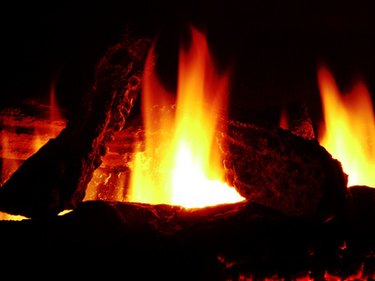
Fireplace fires generate a tremendous amount of heat. Efficiently moving the heat into the room, however, can be an issue. One of the best ways is a fireplace heat exchanger. Operating on the principle of hot air rising and cold air moving to replace the hot air, a heat exchanger transfers the heat with a hot jet action and raises the room temperature appreciably in just a short time.
Materials
Video of the Day
The heat exchanger is nothing more than a pipe with a small opening at one end and a larger opening at the bottom. What's needed are several 5-foot lengths of galvanized threaded steel pipe, a pipe bender rented from a tool rental supply house (a curved grip attached to a long handle), five end caps for one end of each pipe, two 22-inch lengths of steel bar (1-inch diameter will do), 10 3-inch bolts and matching nuts and an electric drill with the largest possible metal drilling bit and a bit sized to fit the bolts.
Video of the Day
Bending the pipe
Begin by bending each of the pipes into equal size "C" shapes. Allow a longer section on the bottom of the "C" than the top as this is where the fire will rest. Curve the pipe until the ends are about 24 inches apart and pointed in the same direction.
Drilling
Drill bolt holes in each pipe through both walls in the top and bottom of the "C." Drill five holes centered in each piece of steel bar starting at 1 inch from one end and spaced every 5 inches. Also, drill out the largest possible hole centered in the five end caps. Make several plunges if necessary to drill out a 1-inch hole in the 2-inch cap. File the edges of the holes smooth.
Assembly
Screw the end caps on the top of each pipe. Bolt one steel bar to the bottom of each pipe and the other steel bar across the top. This will create a 22-inch wide heat exchanger consisting of five equally spaced pipes. Priming and painting the exchanger with heat-resistant metal paint (available from auto supply stores) will add length to the life of the heat exchanger.
Set up
Place four fire bricks in the fireplace and set the heat exchanger on top. Elevating the heat exchanger will improve air flow in the fireplace. It's now ready for the fire. Build the fire inside the heat exchanger's "C" area. As the fire heats the pipes, hot air will be forced out of the top of the pipe through the smaller hole in the end cap. Cold air will be drawn in through the wider hole at the bottom. This "jet" created by the smaller hole will quickly add hotter air to the area in front of the fireplace and the room.
Variations
The dimensions and number of pipes are for a smaller fireplace. For larger fireplaces, add length to the steel bar connecting the pipes, add more pipes to the heat exchanger. Consider using longer pipes to bend into a larger "C." It is best, though, to avoid using larger diameter pipes than 2 inches. Going larger reduces the jet action of the air and will impede adequate flow to warm a given space.